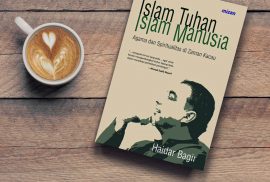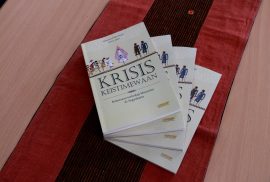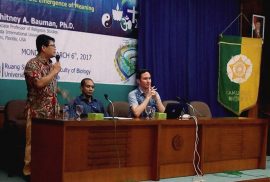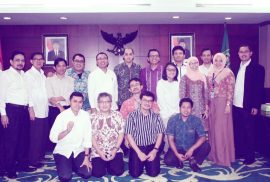A.S. Sudjatna | CRCS | Liputan

“Tidak banyak orang yang berpikir bahwa ada ‘Islam Tuhan’ dan ada ‘Islam manusia’. Kebanyakan orang selama ini berpikir bahwa Islam itu, ya, hanya Islamnya Tuhan.” Demikian ungkap Dr. Haidar Bagir di awal peluncuran buku terbarunya yang berjudul Islam Tuhan Islam Manusia: Agama dan Spiritualitas di Zaman Kacau (Mizan, 2017) pada Jumat, 7 April 2017. Acara bedah buku ini diadakan oleh Laboratorium Studi al-Quran dan Hadis (LSQH) di Convention Hall UIN Sunan Kalijaga.
Membuka diskusi, Dr. Haidar Bagir menjelaskan dua dari sekian alasan yang membuatnya memilih judul bagi karya yang menjadi penanda ulang tahunnya yang keenampuluh itu. Pertama, menurutnya, Islam yang kini dipahami oleh seluruh muslim adalah “Islamnya manusia”, bukan Islamnya Tuhan. Artinya, apa yang dipahami oleh setiap muslim saat ini sebagai Islam atau ajaran Islam adalah keislaman yang sudah melalui proses tertentu, yakni melewati saringan otak dan hati masing-masing individu, yang tentu saja tidak kosong dari beragam faktor, termasuk nafsu di dalamnya. Karenanya, ia berbeda dengan Islam yang seutuhnya dikehendaki Tuhan. Dalam hal ini, manusia hanyalah berupaya untuk memahami Islam untuk sedapat mungkin mendekati yang dimaui Tuhan.
Dengan memahami hal ini, menurut Dr. Haidar, siapapun akan sadar bahwa setiap muslim, sepintar dan sealim apa pun, tetap memiliki peluang kesalahan sekecil apa pun di dalam pehamanan keislamannya. Tidak ada seorang pun—selain Rasulullah Saw.—dari barisan umat Islam yang pemahaman keislamannya itu mutlak betul. Dalam pandangan Dr. Haidar, jika ada orang yang menganggap bahwa hanya pemahaman keislamannyalah yang mutlak benar sedangkan yang lain mutlak salah, dia telah menempatkan dirinya sebagai Tuhan atau wakil Rasulullah.
Seharusnya, lanjut Dr. Haidar, kita belajar kepada para imam mazhab seperti Imam Syafi’i atau Imam Malik yang secara sadar mengatakan bahwa pendapatnya adalah pendapat yang benar namun tetap berpeluang salah; dan pendapat yang lain salah namun tetap berpeluang benar. Dengan begitu, siapapun tak akan berupaya memonopoli kebenaran. “Sekarang enggak; kalau melawan pendapat saya, berarti melawan Tuhan!” ujar Dr. Haidar mengungkapkan kesedihannya atas sekelompok umat Islam yang kerap menuduh sesat muslim lain dari luar golongannya.
Dr. Haidar juga menjelaskan bahwa ada kemungkinan untuk muncul lebih dari satu tafsir yang sama-sama benar dalam memahami kitab suci. Ini karena adanya sudut pandang atau pendekatan yang berbeda dalam membacanya. Menjelaskan ini, Dr. Haidar menggunakan analogi piramida: “Kalau kita lihat sejajar mata, maka tampak segitiga; kalau lihat dasarnya, maka segi empat; kalau dari atas lurus, maka jadilah seperti titik.” Perbedaan pandangan ini bukanlah sebentuk kekeliruan, namun parsialitas. Menguatkan pandangannya, Dr. Haidar menyitir ucapan Rumi bahwa kebenaran itu laiknya cermin yang jatuh ke bumi dan pecah berkeping-keping, lalu setiap orang mengambil satu kepingannya.
Alasan kedua memilih judul tersebut adalah bahwa Islam, menurut Dr. Haidar, diturunkan untuk manusia, bukan untuk Tuhan. Agama adalah seperangkat ajaran yang diturunkan demi kebaikan manusia. Di antara cara untuk itu, Dr. Haidar menekankan, adalah dengan menginternalisasi sifat Tuhan yang secara khusus tercantum dalam ucapan basmalah: ar-Rahman dan ar-Rahim. Orang Islam yang baik adalah orang yang menghabiskan hidupnya menebar kasih sayang ke semua manusia, menjadi agen rahman-rahim. Dan adalah keanehan, jika ada orang yang mendaku membela Tuhan namun begitu bernafsu membinasakan manusia, seolah-olah semakin banyak membunuh semakin ia mendapat rida Tuhan.
Di tengah-tengah diskusi, Dr. Haidar mengutarakan beberapa hal terkait isi buku setebal 288 halaman itu. Di antara yang sempat ditekankannya ialah tentang sejarah perang Nabi. Karena ada banyak narasi peperangan tertulis dalam literatur sirah Nabi, beberapa orang mengira bahwa perang adalah bagian esensial dari agama Islam. Padahal, jika dijumlah hari-hari yang digunakan Nabi untuk berperang, paling hanya dua tahun lebih sedikit saja dari total 23 tahun kerasulan beliau. “Bahkan,” lanjut Dr. Haidar, “ada penelitian yang minimalis, yang tidak memasukkan sariyyah, sehingga jika dijumlah perangnya Nabi hanya delapan puluh hari saja.” (Catatan redaksi: Dalam terminologi literatur sirah Nabi, sariyyah adalah ekspedisi pasukan tanpa dipimpin dan tak didampingi Nabi; ini yang membedakannya dari ghazwah yang dipimpin langsung oleh Nabi.)
Jika diajarkan dengan benar, Islam sebetulnya adalah agama yang menekankan perdamaian dan cinta kasih, bukan agama peperangan dan kebencian. Menegaskan hal ini, Dr. Haidar mengutip Imam Ja’far Shadiq yang secara retoris pernah berucap, “Hal al-din illa al-hubb?” (Apalagi agama itu kalau bukan cinta?) Sejalan dengan ini ialah sabda Nabi, “Cinta adalah asas(agama)ku” (al-hubb asasi). Kalau ada perintah mempersiapkan diri untuk berperang, seperti ditemukan dalam QS al-Anfal [8]:60, menurut Dr. Haidar, itu adalah tindakan preventif menghadapi serangan kelompok lain, dan bukan ditujukan untuk tindakan ofensif.
Hal lain yang juga sempat ditekankan Dr. Haidar dalam diskusi buku ini adalah tentang istilah yang populer dipakai untuk menyebut non-muslim, yaitu “kafir”. Dr. Haidar lugas menuturkan bahwa tidak seluruh non-muslim dapat dikategorikan kafir. Non-muslim yang dapat dikategorikan kafir hanyalah non-muslim yang telah menerima dakwah Islam dan telah sangat jelas memahaminya sebagai suatu kebenaran tetapi dengan sadar memilih untuk mengingkarinya karena vested interest atau alasan lain. Hal ini berdasar pada argumen-argumen dari nash al-Quran, hadis, dan pendapat para ulama lampau yang lebih detail dijelaskan di buku itu. “Untuk menyatakan non-muslim sebagai kafir itu harus ada qiyamul-hujjah,” ungkap Dr. Haidar, “Kalau Islam yang sampai kepada mereka tidak cukup meyakinkan mereka, itu berarti hujjah belum tegak, dan karena itu bukan kafir.” Dengan ini, ia mewanti-wanti agar kita tidak mudah mengobral tuduhan sesat dan kafir kepada orang yang berbeda mazhab atau beda keyakinan.
Menutup ceramahnya, Dr. Haidar menawarkan bahwa Islam paling baik diajarkan dengan memberikan penekanan pada aspek spiritualitas. Baginya, tasawuflah yang mewadahi aspek cinta dalam Islam. “Banyak umat Islam lupa kalau Islam bukan hanya terdiri dari rukun Islam dan rukun iman. Ada rukun yang merupakan puncak keimanan dan keislaman, yaitu rukun ihsan, yang ada dalam tasawuf. Ihsan inilah yang melahirkan cinta. Hilangnya ihsan membuat keislaman seseorang menjadi kering dan penuh kebencian,” pungkas Dr. Haidar.
Penulis, A.S. Sudjatna, adalah mahasiswa CRCS angkatan 2015.
Berita
A.S. Sudjatna | CRCS | Berita

“Terpujilah Engkau, Tuhanku, karena Saudari kami, Ibu Pertiwi, yang menyuapi dan mengasuh kami, dan menumbuhkan aneka ragam buah-buahan, beserta bunga warna-warni dan rumput-rumputan. Saudari ini sekarang menjerit karena kerusakan yang telah kita timpakan kepadanya, karena tanpa tanggung jawab kita menggunakan dan menyalahgunakan kekayaan yang telah diletakkan Allah di dalamnya.”
Begitulah Paus Fransiskus memulai bait-bait awal ensiklik keduanya. Didahului dengan ucapan “Laudato Si’, mi’ Signore,” “Terpujilah Engkau, Tuhanku,” yang ia kutip dari ucapan Santo Fransiskus dari Asisi, pendahulunya ratusan tahun lalu, Paus Fransiskus memulai penegasan sikapnya yang lahir dari refleksi keimanan atas realitas dunia yang hadir saat ini. Dua ratus empat puluh enam paragraf dari keseluruhan ensiklik ini berbicara soal bagaimana seharusnya manusia beragama dan beriman bersikap atas alam dan lingkungannya.
Ensiklik Laudato Si ini sejatinya adalah seruan profetik pemimpin tertinggi Gereja Katolik yang disandarkan pada ajaran keimanan Katolik. Sebuah ensiklik tak hanya merespons realitas sosial, namun juga mengungkapkan basis teologisnya, sehingga aksi-aksi implementatif terhadap ensiklik bukan hanya merupakan gerakan sosial melainkan juga gerakan keagamaan.
Membahas relevansi ensiklik ini dalam konteks Indonesia, Muda-Mudi Katolik (MUDIKA) Paroki Santo Antonius Kotabaru Yogyakarta mengadakan diskusi dengan judul Memandang Petani Kendeng dengan Ensiklik Laudato Si pada Selasa, 4 april 2017, di GKS Widyamandala. Diskusi ini dilatarbelakangi antara lain oleh keprihatinan akan kurangnya perhatian kawan-kawan muda Katolik atas perlawanan para petani terhadap pendirian pabrik semen di pegunungan Kendeng, padahal Gereja Katolik memiliki Ensiklik Laudato Si yang dapat menjadi basis gerakan untuk merespons persoalan semacam itu.
Dalam acara tersebut, pemantik diskusi Lilik Krismantoro memulai pembahasan dengan latar sejarah ensiklik. Ada banyak ensiklik yang sudah dikeluarkan gereja. Salah satu ensiklik yang cukup dikenal dan berpengaruh adalah Ensiklik Rerum Novarum yang dikeluarkan oleh Paus Leo XIII. Ensiklik ini merespons perkembangan komunisme di Eropa pada abad ke-18 dan memicu terbentuknya gerakan buruh Katolik. Ensiklik ini membahas dukungan gereja atas hak-hak buruh namun juga mengukuhkan hak milik pribadi dan menolak sosialisme.
Ensiklik Laudato Si merupakan salah satu dari dokumen-dokumen serupa yang lahir kemudian. Ensiklik ini dapat dibaca sebagai lanjutan dari ensiklik serupa sebelumnya, Populorum Progressio, yang dikeluarkan oleh Paus Paulus VI pada 26 Maret 1967 yang hadir sebagai refleksi iman Katolik tentang pembangunan yang berpusat pada manusia. Di luar ensiklik ini, ada praksis-praksis teologis lain yang lahir dari Gereja Katolik, seperti teoologi pembebasan yang menemukan pengejawantahannya dalam perjuangan Uskup Agung San Salvador Mgr Oscar Arnulfo Romero—yang mengalami assasinasi dan belakangan telah ditahbiskan sebagai martir oleh Paus Fransiskus pada 2015.
Terkait persoalan lingkungan, menurut Lilik, Gereja Katolik di Indonesia sebenarnya sudah mulai terlibat aktif sejak lama. Ini tampak misalnya dari keterlibatan Gereja Ganjuran di Yogyakarta sebagai tuan rumah seminar pertanian se-Asia pada tahun 1990 yang diadakan oleh Federasi Konferensi-Konferensi Waligereja Asia (FABC). Dengan bekal beragam gerakan gereja dan ensiklik sebagai pijakan teologisnya, menghubungkan persoalan Kendeng dengan Katolik bukan hal yang sulit. Gereja dan umat Katolik memiliki modal dan alasan yang cukup untuk terlibat aktif dalam persoalan Kendeng.
Menegaskan hal ini, salah seorang peserta diskusi yang juga aktivis pertanian organik, Beni Pudyastanto, mengatakan bahwa secara khusus Ensiklik Laudato Si membahas persoalan air di bab pertama bagian kedua. Dikatakan dalam ensiklik itu bahwa air dapat menjadi sumber konflik. Dalam kasus Kendeng, isu seputar Cekungan Air Tanah (CAT) Watuputih Kendeng adalah salah satu persoalan kunci yang mengemuka dalam polemik kehadiran pabrik semen di Kendeng. Air di CAT akan hilang atau menyusut sebab aktivitas penambangan, yang pada gilirannya merusak suplai air untuk wilayah Rembang, Kudus, Pati, Blora dan sekitarnya.
Beni juga mengingatkan peserta diskusi bahwa Laudato Si mengatakan bahwa keberlanjutan (sustainability) suplai dan ketersediaan air adalah anugerah bagi semua makhluk, dan di level ini manusia dengan makhluk lain berposisi sejarah di hadapan Tuhan. Akal budi yang dimiliki manusia tidak serta merta memberinya hak mutlak untuk mengeksploitasi alam.
Beni juga menegaskan bahwa membicarakan Kendeng dari kaca mata Laudato Si bukan semata-mata berbicara perihal lingkungan, namun juga soal adanya kelompok masyarakat yang butuh dibela di hadapan arogansi kekuasan. Dalam hal ini, ajaran Katolik tentang menolong sesama dan kaum tertindas seharusnya dapat menjadi landasan aksi. Maka, lanjut Beni, Ensiklik Laudato Si ini harus digaungkan sampai ke paroki-paroki hingga akar rumput. Untuk memulai semua itu, menurut Beni, hal pertama harus dilakukan adalah sebagaimana dibahas pada bab enam bagian tiga Ensiklik Laudato Si: pertaubatan ekologis. Setiap penganut Katolik harus bertaubat dari dosa-dosa ekologisnya.
Terkait kelompok miskin tertindas, Lilik menambahkan bahwa saat terjadi ketidakadilan ekonomi dan ekologi, korban terbanyak dan paling utama itu sama: masyarakat miskin. Merekalah kelompok yang paling rentan terdampak bencana akibat rusaknya lingkungan. Lilik mengingatkan peserta bahwa kini telah hadir jenis pengungsi baru, pengungsi lingkungan, yakni pengungsi yang lahir dari kerusakan lingkungan. Menyitir Laudato Si, Lilik mengingatkan bahwa konsep hutang semestinya tak hanya dipahami dalam kerangka finansial, tetapi juga ekologis, yakni hutang negara-negara maju karena mereka mengakses sumber daya alam dan mengorbankan masyarakat miskin dunia ketiga.
Menutup diskusi, Lilik mengajak peserta untuk merenungi iman masing-masing dengan pertanyaan retorisnya: “Harus disadari bahwa hati yang kaugunakan untuk mengasihi itu adalah hati yang sama dengan yang kaugunakan untuk merusak lingkungan. Itu bukan hati yang terpisah. Jadi, bagaimana kita bisa mengasihi jika pada saat yang sama kita merusak alam?!”
Penulis, A.S. Sudjatna, adalah mahasiswa CRCS angkatan 2015.

Yogyakarta telah lama menjadi rumah yang aman bagi berbagai tradisi, keyakinan, dan paham pemikiran yang beragam. Tetapi Daerah Istimewa ini belakangan disorot karena banyaknya aksi vigilantisme yang dilakukan sejumlah kelompok massa baik yang berlatar belakang agama atau politik. Aksi-aksi vigilantisme yang menyasar kelompok-kelompok sosial dan keagamaan minoritas menimbulkan pertanyaan apakah Yogyakarta, yang dikenal sebagai kota pendidikan dan pusat kebudayaan Jawa yang menekankan pada harmoni sosial, sudah berubah menjadi daerah yang intoleran? Laporan ini menunjukkan bahwa vigilantisme terhadap minoritas tidak cukup secara sederhana dipahami sebagai ekspresi konservatisme keagamaan dan intoleransi para pelaku terhadap minoritas, tetapi juga merupakan bagian dari proses perubahan sosial dan struktural yang diantaranya dipengaruhi oleh dinamika seputar status keistimewaan Yogyakarta. Tidak bisa dipungkiri, sektarianisme yang menguat belakangan ikut berpengaruh, tetapi seringkali kekerasan terhadap minoritas lebih tampak sebagai alat mobilisasi kelompok-kelompok kepentingan tertentu untuk mempertahankan basis sosial-politik yang menentukan kendali mereka atas ruang dan sumber daya.
_________________________
Judul: Krisis Keistimewaan: Kekerasan terhadap Minoritas di Yogyakarta
Penulis: Mohammad Iqbal Ahnaf & Hairus Salim
Penerbit: CRCS UGM
ISBN: 978-602-72686-7-8
Tebal: 134 halaman; 15×23 cm
Cetakan Pertama: April 2017
Harga: Rp60.000,00
__________________________
Narahubung untuk mendapatkan buku ini:
Divisi Marketing CRCS UGM
Gedung Lengkung Lantai 3
Sekolah Pascasarjana Lintas Disiplin Universitas Gadjah Mada
Jl. Teknika Utara, Pogung, Yogyakarta, Indonesia 55281
Telephone/Fax: 0274-544976
Atau melalui WA: 082141724150 (Bandri)
Lihat juga buku-buku publikasi CRCS yang lain di sini.
Anang G Alfian | CRCS | News

Universitas Gadjah Mada’s Faculty of Biology invited Whitney Bauman to present his on-going project at the Biology Hall on Monday, March 6th, 2017. Students and lecturers from various faculties came to hear his lecture. His specialization on the discourse of religion, science, and nature reflects his capacity as an associate professor at the Department of Religious Studies, Florida International University, as well as author of works including Theology, Creation, and Environmental Ethics (Routledge 2009) and Religion and Ecology: Developing a Planetary Ethics (2014). A longtime friend of CRCS who has taught intersession courses more than once, he is currently working to finish his third, single-authored book with a tentative title Truth, Beauty and Goodness: Ernst Haeckel and Religious Naturalism.
In his lecture, introduced by paleontology lecturer Donan Satria Yudha as the moderator, Bauman engaged religion and science in a contemporary discussion to look for a new way of understanding each through an evolutionary perspective. This perspective of religion-science relationship was inspired by the contemporary phenomenon in which religion has gained more spaces within science.
The emphasis Bauman made in the beginning of the lecture pointed out the direction of his topic of presentation. He started how historically the notion of religion has been discussed by different perspectives from dualism and reductionism to emergence theory. Along with the continuum of religion-science relationship, he challenged to look at the relation in a new way by focusing on the German scientist Ernst Haeckel (1834-1919) who formulated a new way of making sense out of the world through his studies of ecology and evolution. Bauman clearly stated his stance: “to place Haeckel’s Monism in continuity with this tradition of meaning-making.” He also emphasized that everything has undergone changes and the way we understand the relation between religion and science has always been a “relationship in constant flux.” He challenged the assumption of the previous models on religion-science relationship that views Religion and Science as two different traditions. “I argue that Religion and Science are always together, influencing one another,” Bauman continued, “there is no clear separation.”
As Bauman prefers to define “religion” through its meaning-making function, he observed that the way religion attains knowledge is also inseparable from the natural evolution perspective. Further, he explained that the relation involves not only human and nature as a traditional dichotomy but more as an interconnectedness of everything. This view triggered questions from the audience.
One member of the audience asked a question on a human special status over the rest of nature which challenged the way certain traditions or religions view the status of humans in their scriptures. “I am not sure if humans have a special status in nature,” Bauman answered, “In fact, not only humans have culture and language; many other creatures might have them too.” Because knowledge is always in process and moves together with history and experiences, he argued that it is normal for many traditions to have different understandings of nature and the Truth.
Another question posed was about whether the first human walking on earth was the one as narrated in the scripture. Baumann referred to “Adam” as mentioned in the Genesis as its literal meaning, i.e. a creature on the earth which did not refer to any specific gender. In addition, Donan Satria Yudha said that some Muslim scientists say that Homo sapiens may constitute the first human as mentioned in the scripture and it refers to the quality of being human in the evolution, and not to a specific figure.
The writer, Anang G Alfian, is CRCS student of the 2016 batch
Subandri Simbolon | CRCS | Berita

Agar tak salah arah, kebijakan seharusnya berdasar pada riset. Kesenjangan antara kebijakan dengan pengetahuan acapkali berujung pada kebijakan yang tak menyelesaikan masalah. Termasuk di sini kebijakan yang berkenaan dengan umat beragama.
Untuk menjembatani pemerintah dengan akademisi, pada 14 Februari 2017 Balitbang Kementerian Agama bekerja sama dengan Pusat Studi Agama dan Demokrasi (PUSAD) Paramadina mengadakan diskusi dengan topik mengenai definisi agama dan penodaan agama sebagai rangkaian dari serial diskusi “Analisis Kebijakan: Riset dan Kebijakan Terkait Kehidupan Beragama di Indonesia”. Serial diskusi ini direncanakan akan menghasilkan buku terkait tema-tema seperti intoleransi, konflik agama, kebebasan beragama dan berkeyakinan, dan kerukunan antarumat beragama. Forum diskusi itu dihadiri berbagai kalangan dari pihak Kemenag, termasuk Menteri Agama Lukman H. Saifuddin, para akademisi dan aktivis. Dua dosen Program Studi Agama dan Lintas Budaya (CRCS), Dr Samsul Maarif dan Dr Zainal Abidin Bagir, menjadi pembicara dalam forum itu.
Definisi Agama
Samsul Maarif memaparkan ulasannya dengan tajuk “Meninjau Ulang Definisi Agama, Agama Dunia, dan Agama Leluhur”. Ia menyampaikan bahwa definisi agama saat ini cenderung diskriminatif karena menggunakan paradigma “agama dunia” (world religion) untuk menilai agama lokal. Paradigma ini dalam diskursus klasik Barat prototipenya adalah Kristen sedangkan dalam konteks Indonesia adalah Islam. Agama-agama lokal, dalam paradigma ini, cenderung menempati posisi yang lebih rendah. Penggunaan paradigma agama dunia itu bukan saja menyusup ke dalam cara pengambilan kebijakan oleh pemerintah, melainkan juga telah menghantui dunia akademik di Indonesia.
Berdasar pada kritik itu, Samsul menyampaikan bahwa pemahaman mengenai agama yang cenderung esensialis harus dihindari, karena agama mesti dipahami secara diskursif berdasarkan konteks waktu, tempat, dan sejarahnya. Yang sebenarnya lebih diperlukan adalah mempertimbangkan definisi dari segi efektifitasnya dalam memecahkan masalah. Dalam hal ini, definisi yang dibuat seharusnya dapat membebaskan kelompok-kelompok tertentu, utamanya kalangan penganut agama leluhur, dari perlakukan diskriminatif.
Di samping itu, Samsul menegaskan bahwa kebijakan dan studi terhadap para penganut agama leluhur mesti dilakukan dalam konteks keragaman agama, yakni bahwa para penganut agama leluhur mendapat kebebasan untuk mendefenisikan agama mereka sendiri. Pemerintah diharapkan dapat memfasilitiasi self-determinism warganya dan melihat mereka sebagai warga negara yang setara. Definisi yang baik adalah definisi yang mampu memberikan hak-hak yang setara pada semua penganut agama, baik agama-agama dunia maupun agama-agama leluhur dan kepercayaan, di Indonesia.
Kebebasan Beragama dan Berkeyakinan
Dalam forum yang sama, Dr Zainal Abidin Bagir berbicara untuk tema “Kajian tentang Kebebasan Beragama dan Berkeyakinan di Indonesia dan Implikasinya untuk Kebijakan”.
Zainal memaparkan diskusi mutakhir tentang Kebebasan Beragama dan Berkeyakinan (KBB) baik di tingkat internasional maupun nasional serta tema-tema yang menonjol. Ia menegaskan bahwa dalam diskursus di tingkat internasional KBB bukanlah konsep yang sudah fixed dan statis, namun mengalami perkembangan hingga saat ini. Di antara masalah yang masih kerap muncul hingga kini dalam diskusi KBB adalah pertentangan antara mereka yang mengklaim universalitas KBB, sebagai bagian dari Deklarasi Universal Hak Asasi Manusia (DUHAM), dan negara-negara yang menggunakan sudut pandang partikularistik, yang merelatifkan KBB.
Terlepas dari itu, perkembangan yang menarik adalah regionalisasi HAM, yaitu diadopsinya HAM oleh beberapa regional, termasuk Uni Eropa, ASEAN, dan Organisasi Kerja Sama Islam (OKI). Lebih jauh, meskipun ada kecenderungan partikularistik itu, dalam perkembangannya HAM ASEAN dan OKI cenderung mengalami konvergensi ke HAM internasional.
Di Indonesia sendiri, Zainal melihat beberapa perkembangan penting HAM setelah 1998, termasuk ratifikasi beberapa kovenan, dan masuknya klausul khusus mengenai HAM dalam amandemen Undang-Undang Dasar. Selanjutnya, terjadi pengarusutamaan KBB dalam berbagai UU. Perkembangan ini menurut Zainal menjadi sebuah nilai plus bagi Indonesia jika dibandingkan dengan perkembangan regional, khususnya jika dibandingkan dengan banyak negara ASEAN dan OKI. Di Indonesia pun, partikularisasi KBB terjadi, yakni dalam menghadapkan HAM dengan apa yang dianggap sebagai kultur Indonesia dan aspirasi keagamaan sebagian kelompok beragama, khususnya muslim. Salah satu bentuk partikularitas itu diekspresikan dalam konsep “kerukunan”, yang hingga tingkat tertentu menjadi pembatas kebebasan.
Di bagian akhir paparannya, Zainal mengajukan beberapa rekomendasi untuk pengembangan kajian dan perumusan kebijakan terkait KBB. Pertama, “membumikan” KBB dalam tradisi kultural atau keagaman untuk memperluas tingkat penerimaan publik. Kedua, perlunya ada kajian komparatif dengan praktik-praktik kebijakan KBB di negara-negara lain untuk memperkaya perspektif dalam mengidentifikasi faktor-faktor yang menyumbang atau menghambat keberhasilan perumusan maupun implementasi kebijakan. Ketiga, perlunya ada perhatian pada best practices dari praktik-praktik yang sudah terjadi agar kajian kebijakan tak hanya melihat aspek legal secara abstrak namun juga situasi dan kondisi yang memungkinkan keberhasilan perumusan dan penerapan kebijakan.
Batas minimal? 
Dalam sesi tanya jawab, Menteri Agama Lukman Hakim Saifuddin mengajukan satu pertanyaan tentang batas minimal yang harus dilakukan negara dalam Perlindungan Umat Beragama (PUB). Andreas Harsono, dari Human Rights Watch, menjawab bahwa batas minimal adalah tidak terjadinya kekerasan kepada kelompok keagamaan manapun. Zainal melanjutkan dengan menyampaikan bahwa hak-hak administrasi kependudukan, kebebasan beribadah harus dipenuhi bagi semua pemeluk agama, terlepas dari bagaimana agama didefinisikan.
Kasus-kasus yang acapkali terjadi adalah sulitnya sebagian kalangan untuk mendapatkan hal-hak konstitusionalnya. Di beberapa daerah, hak-hak dasar pemeluk agama leluhur belum terlayani secara penuh. Misalnya, seorang anak tidak bisa dimasukkan dalam Kartu Keluarga orang tuanya hanya karena perkawinan mereka berdasarkan agama leluhur dan tak dapat dicatat dalam pencatatan sipil. Hal ini para gilirannya berakibat pada hilang atau berkurangnya akses-akses dalam bidang lain seperti pendidikan, kesehatan dan hak politik.
Di akhir diskusi, Menteri Agama menyampaikan bahwa Kementerian Agama terbuka untuk menerima masukan dari semua pihak, khususnya dalam upaya merumuskan RUU Perlindungan Umat Beragama yang sedang diproses.

Abstract:
Urban people are always exposed to soundscape, to sounds and noises in their everyday life. With the aid of technology, the soundscape of Yogyakarta has dramatically changed in the last 30-40 years. The sounds which once gave certain characteristics to the city have changed both quantitatively and qualitatively. For most people it does not bother them if they do not pay attention to them. However, people accept certain sounds as acceptable sounds while some other may reject them as disturbing noises. The result of such perceptions create spsychologically different responses, either positively or negatively. Therefore, exploring how people in the City of Tolerance responding to the religious soundscape of the place where they live is an effort to see an interfaith relationship from a different perspective, the auditory angle.
Speaker:
Jeanny Dhewayani, Ph.D. is the Associate Director of Indonesian Consortium for Religious Studies (ICRS) Yogyakarta.She got her Master degree from University of New Mexico and Ph.D. from Australian National University, both in Anthropology. Now, She is also a professor of anthropology at Duta Wacana Christian University.







